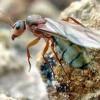- Formiculture.com
- Forums
- Gallery
- Members
- Member Map
- Chat

Queen Ant ID June 1 2018 Denver CO
Started By
Swinferret
, Jun 1 2018 9:03 PM
8 replies to this topic
#1
 Offline
-
Posted June 1 2018 - 9:03 PM
Offline
-
Posted June 1 2018 - 9:03 PM
Denver Colorado USA
Found on my kitchen floor and saved from my cat. Captured on May 11th after a rainy storm so nuptial flight is probable. Habitat: city/foresty area
About 2cm in length , hard to measure because she wanted to move around
Completely smooth
Red and black body
I'm positive she is a queen because she laid a clutch of 3 eggs!!
I'm thinking she's some form of Camponotus (sorry if I mispelled) her gaster seems smaller so I'm hoping she's not malnurished or semi clausteral . Thank you for the help!
Found on my kitchen floor and saved from my cat. Captured on May 11th after a rainy storm so nuptial flight is probable. Habitat: city/foresty area
About 2cm in length , hard to measure because she wanted to move around
Completely smooth
Red and black body
I'm positive she is a queen because she laid a clutch of 3 eggs!!
I'm thinking she's some form of Camponotus (sorry if I mispelled) her gaster seems smaller so I'm hoping she's not malnurished or semi clausteral . Thank you for the help!
#2
 Offline
-
Posted June 1 2018 - 9:13 PM
Offline
-
Posted June 1 2018 - 9:13 PM
You need to post photos in order to get an ID, but I am thinking Camponotus as well (you did not misspell ![]() ). (I would HIGHLY recommend embedding the photos into your post as some people may not ID your queen)
). (I would HIGHLY recommend embedding the photos into your post as some people may not ID your queen)
Use: http://www.formicult...o-post-photos/ (I would recommend using Imgur or the Formiculture gallery or both. NO NOT USE PHOTOBUCKET!)
Edit: Remember, Camponotus sp. queens are not semi-claustral so that shouldn't be a problem, but maybe feeding her a tiny drop of sugar water wouldn't hurt. Good Luck with fertility!
Edited by EnderzATwar411, June 1 2018 - 9:23 PM.
- rbarreto and Swinferret like this
![]()
![]()
![]()
![]()
Ex igne et in infernum.
#3
 Offline
-
Posted June 1 2018 - 9:22 PM
Offline
-
Posted June 1 2018 - 9:22 PM
Thanks I tried posting my photo but my file was wonky
Here she is in as much detail that I can muster!
Let me know if link does not work
Here she is in as much detail that I can muster!

Let me know if link does not work
- Enderz likes this
#4
 Offline
-
Posted June 1 2018 - 9:29 PM
Offline
-
Posted June 1 2018 - 9:29 PM
#5
 Offline
-
Posted June 1 2018 - 9:38 PM
Offline
-
Posted June 1 2018 - 9:38 PM
Yes the photos work ![]() . I agree with Phoenix, it looks to be Camponotus novaeboracensis.
. I agree with Phoenix, it looks to be Camponotus novaeboracensis.
- Swinferret likes this
![]()
![]()
![]()
![]()
Ex igne et in infernum.
#6
 Offline
-
Posted June 3 2018 - 11:57 AM
Offline
-
Posted June 3 2018 - 11:57 AM
Firstly thank you Phoenix and, EnderzAntwar for providing your insight!! It is appreciated!
https://www.tapatalk...-cam-t8554.html
I saw this post about how noveboracensis can look like other camponotus varieties!
I'm just so uncertain and I wanna know so I can provide my potential colony the best care.
Also her gaster seems bot as plump so I'm hoping it's not a fertile issue
https://www.tapatalk...-cam-t8554.html
I saw this post about how noveboracensis can look like other camponotus varieties!
I'm just so uncertain and I wanna know so I can provide my potential colony the best care.
Also her gaster seems bot as plump so I'm hoping it's not a fertile issue
#7
 Offline
-
Posted June 3 2018 - 12:08 PM
Offline
-
Posted June 3 2018 - 12:08 PM
The ant in that thread you linked is C. chromaioides an eastern species, not likely you'll find it in Colorado. They can be differentiated by having red and really long golden hairs on their gaster (both of these traits can't be seen in your photos). The other possible confusion, C.vicinus tends to be smaller (12-16mm) compared to the other two (15mm-17mm) and has a narrower head, usually not surpassing the width of the mesosoma (thorax). Additionally C. vicinus is associated with arid/desert habitats, whereas the other two, especially C. novaeboracensis are associated with forests, which seems to be more of a deciding factor of its range compared to geographic location.
- Swinferret likes this
#8
 Offline
-
Posted June 3 2018 - 2:14 PM
Offline
-
Posted June 3 2018 - 2:14 PM
Thanks for the clarification and wonderful info LC3!
#9
 Offline
-
Posted June 5 2018 - 8:01 AM
Offline
-
Posted June 5 2018 - 8:01 AM
Your queen looks a lot like the Camponotus queens I've been catching in my front yard! I bet it's likely they are the same species. I'm also still trying to get a very confident ID on mine. Although, it seems like LC3 has a different species guess for my queens. Hmmm... How to know for sure?
0 user(s) are reading this topic
0 members, 0 guests, 0 anonymous users
















